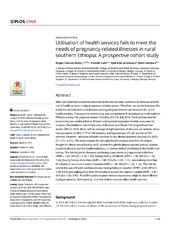| dc.description.abstract | Although maternal survival has improved in the last decades, evidence on illnesses and the use of health services during pregnancy remains scarce. Therefore, we aimed to assess the incidence and risk factors for illnesses among pregnant women and measure the use of health services. A prospective cohort study was conducted in three kebeles in rural southern Ethiopia among 794 pregnant women from May 2017 to July 2018. Each woman was fol- lowed every two weeks at home. Poisson and survival regression models were used for analysis. The incidence rate of episodes of illnesses was 93 per 100 pregnant-woman- weeks (95%CI: 90.6, 94.2), with an average of eight episodes of illnesses per woman. Anae- mia accounted for 22% (177 of 794 women), and hypertension 3% (21 women of 794 women). However, utilization of health services for any illness episodes was only 8% (95% CI: 7.6%, 8.9%). The main reasons for not using health services were that the women thought the illness would heal by itself, women thought the illness was not serious, women could not afford to visit the health institutions, or women lacked confidence in the health insti- tutions. The risk factors for illnesses are having many previous pregnancies in life time (ARR = 1.42; 95%CI = 1.02, 1.96), having history of stillbirth (ARR = 1.30; 95%CI = 1.03, 1.64), having history of abortion (AHR = 1.06; 95%CI = 1.02, 1.11), and walking more than 60 minutes to access the nearest hospital (AHR = 1.08; 95%CI = 1.03, 1.14). The risk fac- tors for low use of health services are also having history of abortion (AHR = 2.50; 95%CI = 1.00, 6.01) and walking more than 60 minutes to access the nearest hospital (AHR = 1.91; 95%CI = 1.00, 3.63). Rural Ethiopian pregnant women experience a high burden of illness during pregnancy. Unfortunately, very few of these women utilize health services. | en_US |

